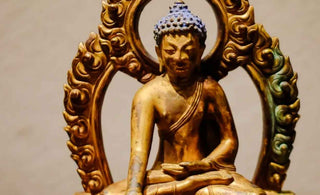
In the realm of Tibetan Buddhist art, the Contemporary Understanding of Tibet Buddha Statues emerges as a dynamic and evolving narrative, bridging ancient traditions with modern perspectives. As contemporary artists engage with the rich cultural heritage, they reinterpret and infuse new meanings into these sacred figures, reflecting the changing landscapes of spirituality and human consciousness.
The contemporary understanding of Tibetan Buddha statues is shaped by a nuanced interplay between tradition and innovation. Modern artists, drawing inspiration from the historical context and their own lived experiences, bring fresh perspectives to the timeless depictions of Buddhas, bodhisattvas, and other divine figures. The evolution is not merely stylistic but also extends to the symbolic and philosophical dimensions embedded in the sculptures.
One notable aspect of the contemporary understanding lies in the expanded representation of gender and diversity. While traditional Tibetan statues predominantly depicted male figures, modern interpretations increasingly feature representations of female Buddhas, diverse enlightened beings, and even non-binary forms. This inclusive approach aligns with contemporary values of diversity and gender equality, reflecting the changing ethos of the present era.
In the pursuit of a contemporary understanding, artists often engage with issues relevant to the modern human experience. Themes such as mindfulness, interconnectedness, and environmental consciousness find expression in the symbolism and narratives of these statues. The Buddha, once a symbol of individual enlightenment, now serves as a metaphor for collective awakening and shared responsibility towards the planet.
Moreover, the materials and techniques employed in creating contemporary Tibetan statues reflect a harmonious fusion of traditional craftsmanship and modern innovation. Artists experiment with a diverse range of materials, including metals, wood, glass, and even recycled elements, embracing sustainability and eclecticism in their creative processes. This not only adds a layer of uniqueness to each sculpture but also resonates with contemporary concerns about environmental stewardship.
The faces of contemporary Tibetan Buddha statues often exhibit a subtle departure from traditional depictions. While these modern interpretations maintain the inherent serenity traditionally associated with Buddha statues, artists have embarked on a quest to infuse these sacred figures with expressions that mirror the multifaceted nature of contemporary life. One poignant example that encapsulates this approach is the "Harmony Unveiled: A Modern Expression of Compassion" statue.
In "Harmony Unveiled," the artist meticulously sculpts the facial features of Avalokiteshvara, the bodhisattva of compassion, with a keen awareness of the challenges faced by the modern world. The eyes, traditionally considered windows to the soul, are crafted with a profound sense of empathy. Unlike the traditional depictions that often convey a detached serenity, the eyes in this contemporary statue reflect an engaged compassion that resonates with the struggles and aspirations of contemporary society.
The subtle curvature of the lips in "Harmony Unveiled" captures a compassionate response to the complexities of the modern human experience. Instead of a stoic expression, the statue features a gentle smile that symbolizes an acknowledgment of both the joys and sorrows inherent in the world. This departure from the strictly serene countenance of traditional statues communicates a compassionate understanding that extends beyond individual enlightenment to encompass a broader and more empathetic response to the challenges faced globally.
The facial expressions in contemporary Tibetan Buddha statues, exemplified by "Harmony Unveiled," go beyond the boundaries of individual spiritual attainment. They become a mirror reflecting the interconnectedness of humanity, acknowledging the collective journey towards harmony, peace, and understanding. The artist's intention is not only to capture the divine but also to create a conduit through which the sacred energy can resonate with the contemporary viewer, inspiring a compassionate engagement with the world.
The choice of sustainable materials in creating "Harmony Unveiled" further deepens its contemporary significance. The artist's conscious decision to embrace eco-friendly materials reflects a commitment to environmental stewardship and a recognition of the interconnectedness of all life. The statue becomes a testament to the artist's awareness of the global challenges posed by climate change, urging viewers to contemplate their role in fostering harmony with the natural world.
One compelling example that encapsulates the essence of the contemporary understanding is the "Transcendent Harmony: Modern Interpretation of Avalokiteshvara." This contemporary masterpiece, sculpted in a synthesis of traditional and modern elements, portrays Avalokiteshvara with a gender-neutral form, emphasizing the universal and non-binary aspects of compassion. The choice of sustainable materials and the incorporation of symbolic elements representing ecological harmony make it a poignant reflection of the contemporary worldview.
Conclusion
In conclusion, the Contemporary Understanding of Tibet Buddha Statues stands as a vibrant dialogue between ancient wisdom and present realities. As artists navigate the delicate balance between tradition and innovation, they contribute to a living tradition that evolves with the changing tides of human consciousness. These contemporary sculptures serve not only as artistic expressions but as mirrors reflecting the aspirations, challenges, and interconnectedness of the contemporary human experience. The ongoing exploration of Tibetan Buddhist art in the modern context is an invitation to engage with the timeless wisdom of the past in ways that resonate with the complexities of our present moment.























